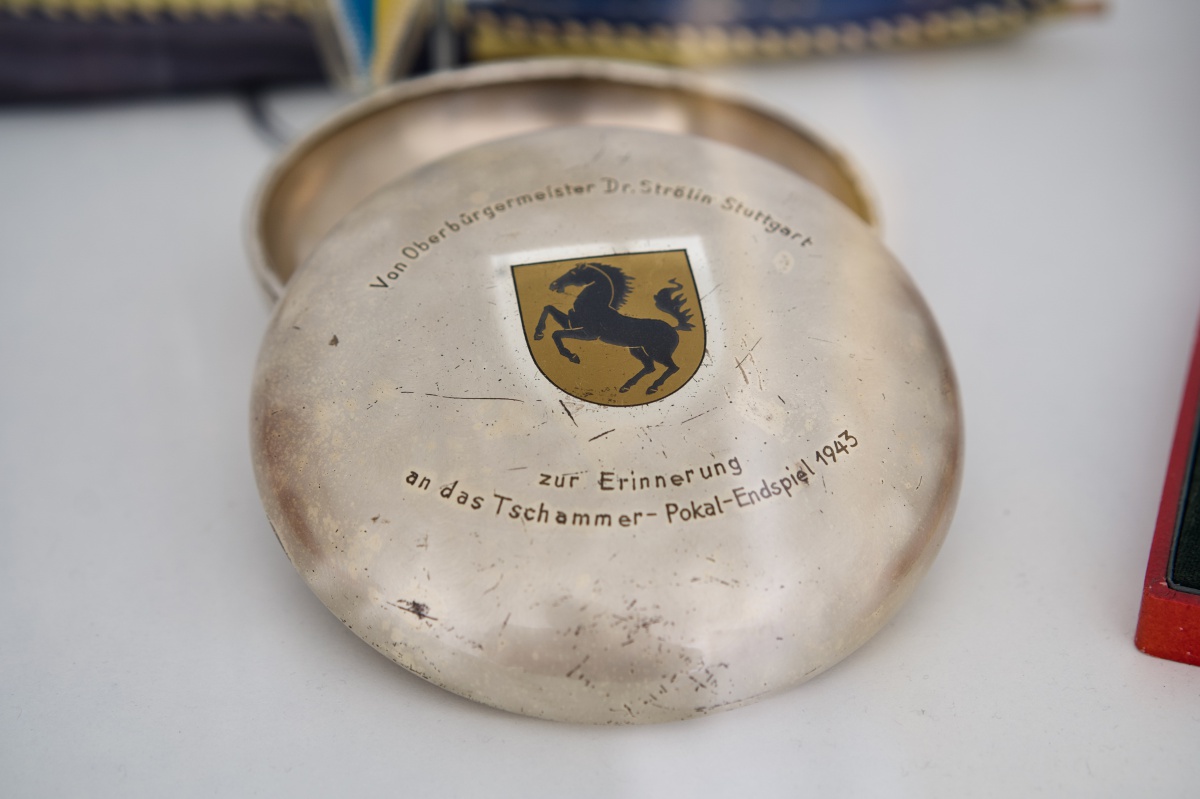The foundation.
The First Vienna Football Club 1894 is the oldest football club in Austria. It was founded on August 22, 1894 by association law. The founding meeting was held on the same day and the logo – designed by William Beale and still existent today – was presented based on Beale’s homeland, the Isle of Man. The following gentlemen entered the membership list at that time: Franz Joli, Max Hans Joli, William Beale, Major, Anlauf, James Black, Brabenetz, Kent, Roberts and Geo Fuchs, who acted as the association's first chairman. As sponsors, Baron Nathaniel Rothschild and General Director Schuster of the Rothschild bank launched the club in the tavern “Zur Schöne Aussicht”. The club colors were determined with blue and yellow, the coat of arms colors of the Rothschild house.The history of the club is closely linked to the history of Austrian football.

When the football game moved to Austria-Hungary in the early 1890s, it first reached Prague, Graz, Baden near Vienna and the metropolis of the old empire itself in 1894. Englishmen based in Vienna founded the Vienna Cricket Club in 1892. In 1894, the Cricketer founded their own football section and renamed themselves First Vienna Cricket and Football Club.
At the same time as the cricketers, some men started playing football on the garden grounds of Baron Rothschild. It started with the stories of the English gardener James Black, who told his colleagues about English football and also taught them the rules. In Franz Joli, the son of the Austrian chief gardener, who had just returned from a stay of several months in England and got to know the football game there, Black soon found a colleague and they both organized the first football match on a baron's meadow. Closed to the public, four Englishmen competed against four Austrians and tore up the lawn splendor of the baron, who loved his gardens. The banker and financier Nathaniel Mayer von Rothschild then prohibited the football players from playing the game on his facilities, but financed the rental of the Kuglerwiese and also paid for the team's training and game operations. Due to this support, the young men immediately decided to establish a club and, out of gratitude, adopted the coat of arms of their patron. The first teams came to their games wearing jockey hats as well as blue and yellow shirts. In the beginning they looked like Jockeys to the baron, who also owned a large and well-known racing team.
Who's the First?
 The First Vienna Cricket and Football-Club (Cricketer) and the First Vienna Football-Club (Vienna) submitted their statutes to the governorate almost simultaneously, thought the documents from the boys of Döbling were processed earlier and the First Vienna FC 1894 received official certification on August 22, 1894 – the club’s founding date. The Cricketer received their certification exactly one day after on August 23, 1894 and had to delete the name First from their club name at the request of Vienna. The Vienna was the oldest football club in Austria. The Englishmen from the Prater, however, who were so keen on the title First, spoke of scandal and corruption. This resulted in a rivalry between the two clubs that went beyond the scope of sports, which would later only exist between the clubs Rapid and Austria.
The First Vienna Cricket and Football-Club (Cricketer) and the First Vienna Football-Club (Vienna) submitted their statutes to the governorate almost simultaneously, thought the documents from the boys of Döbling were processed earlier and the First Vienna FC 1894 received official certification on August 22, 1894 – the club’s founding date. The Cricketer received their certification exactly one day after on August 23, 1894 and had to delete the name First from their club name at the request of Vienna. The Vienna was the oldest football club in Austria. The Englishmen from the Prater, however, who were so keen on the title First, spoke of scandal and corruption. This resulted in a rivalry between the two clubs that went beyond the scope of sports, which would later only exist between the clubs Rapid and Austria.
The first games.
On November 15, 1894, Vienna played the first official football match on Vienna soil against the Vienna Cricket and Football Club. The historic game took place in front of about 300 spectators on the Kuglerwiese, the home of Vienna, and ended with a clear 4-0 win for the Cricketers. In contrast to the Cricketers, whose line up consisted entirely of British people, there were already some Viennese lads in the squad of Vienna. This encounter is still regarded as the birth of Austrian football, although two teams from ATRV Graz competed against each other in the Styrian metropolis on March 18, 1894. The second leg took place on November 29, 1894 on the Jesuitenwiese in the Prater and ended again with a 4-0 win by the Vienna Cricket and Football Club. It was only in the third derby of the two clubs, which took place on April 14, 1895, that Vienna was able to beat the Cricketers for the first time. The game ended with the "standard result" of 4-0 at that time, but this time for the First Vienna FC 1894. After the won dispute over the club name, it was the first sporting success over the competitors from the Prater.
The first successes.
Challenge-Cup and Tagblatt-Trophy 1897–1911.

Vienna is celebrating its first major successes in the Challenge-Cup. This was held for the first time in 1897 and was basically open to all associations of the monarchy. In the semifinals of the competition, First Vienna FC 1894 met their archrival and organiser of the competition, the Vienna Cricket and Football Club. Vienna lost the game on November 15, 1897 on the grounds of the Jesuitenwiese in the Prater with 2-3. The goals of Vienna were scored by Gindl and Nicholson. The Vienna player M.D. Nicholson scored another goal, which however was not recognized by the referee. Thus Nicholson’s goal ensured that from then on every goal had to be provided with goal nets, as had been the practice in football’s home country England for yours.
On November 27, 1898, Vienna won 1-0 against the Cricketers in the semi-final through a goal by Lowe and was thus the first time in the final of the Challenge Cup. In the final, which was held on March 5, 1899 on the Jesuitenwiese in the Prater, Vienna defeated the opponent AC Victoria Wien 4-1 and won their first Challenge-Cup. The team that won the very first title for First Vienna FC 1894 consisted of the players Karl Mollisch, Alfred Marek, M. D. Nicholson, O’Hofer, Anlauf, Niedl, Retzbach, Schönpflug, Eckstein, Hans and Soldat.
In the following season 1899/1900, Vienna defeated Wiener FC 1898 3-1 in the semifinals and won the Cup for the second time after beating the Cricketers in the final on March 11, 1900 with 2-0. Cup. The goal scorers in the final were Eipel (Wilhelm Eipeldauer) and Albert. The winning team was as follows: Erwin Zander, Gilly (Dr. Paul v. Goldberger), Franz Joli, Karl Mollisch, MD Nicholson, Paul Zander, Max Joli, Blooncy, Löwenbein, Eipel (Wilhelm Eipeldauer), Gindl, Albert, Eckstein, Willy Zander. In the following years, however, Vienna was no longer able to make a decisive appearance in the Challenge-Cup and left the competition at an early stage.
The second major competition of the time was the Viennese Tagblatt-Cup. The Cup was held according to a league system. This Cup was played from 1900-1903 and won every year by the Wiener AC. Vienna took the second place in 1902 and 1903.
International and national friendly games.
On November 1, 1899, Vienna played DFC Prague as part of the new sports ground opening. The Prague team had been unbeaten for two years and were considered the best continental team of that time. The team from Prague had traveled to Vienna and said in advance that the Viennese were not going to spoil the party and would therefore never score more than four goals. The Vienna squad formed by coach M. D. Nicholson delivered a sensation with a 2-0 win through goals from Eipel and Gindl. Even the Cricketers from the Prater acknowledged the win with cheers. The Vienna lineup at that time was as follows: Mollisch (goal), Erwin and Paul Zander (defense), Blooncy, Alfred Marek, Gilly (cover), Gindl, Eipel, Albert, Eckstein and Willy Zander (attack).
The new team hurried from victory to victory and was also able to beat the Cricketers on December 3, 1899. This success was particularly important because there was not a single English player in the lineup of First Vienna FC 1894 and thus for the first time a pure Viennese team was able to defeat the Prater club, still largely made up of British. Vienna, headed by Hermann Schönaug from 1899-1904, achieved several other great successes after Nicholson's departure.In 1901, the First Vienna Football Club achieved victories against Slavia Prague (5-3), Graz (7-1), Wiener FC 1898 (8-0) and Wiener AC (4-2). In 1901/02 the boys from Döbling won a tournament in Margarethen and a tournament organised by the Cricketers.
In 1904, Franz Joli, a founding member from 1894, took over the management of the club. The anniversary team of this year was one of the strongest the club had so far and consisted of Pekarna (goal), Eipel, Weiß (defense), Dick, Blooncy, Lencewski, called Lintsch (cover) and Kellner, Kohn, Albert, Weißberg and Kreisl (attack) together. One of the greatest successes this team achieved was a 5-3 away in 1904 win against DFC Prague. At half-time, the Bohemians led 3-0 before Weißberg and Kohn equalized through three goals within five minutes. Kellner led Vienna with two more goals to victory. Also worth mentioning is a 5-3 win over Slavia Prague and a 6-0 win over Sparta Prague. The highlight of the anniversary year was a surprising 4-3 win against the then German champions T.u.FC Union 92 Berlin. This game also showed the unconditional will of victory of the Viennese, who again decided the game in their favor after a 0-3 halftime score.
The first years in the Austrian football championship 1912-1923.
First Vienna FC 1894 has played 68 seasons in the top Austrian division and was a founding member of the first official championship in the 1911/12 season. The boys from Döbling finished sixth in the premier season, however, at the end of the 1913/14 season, they got relegated from top-tier football. Vienna officials were responsible for this relegation and the exit from the league. After relegation games between the bottom team of the first division and the champion of the second division had taken place in the two previous years, Vienna officials applied for the abolition of the relegation games and for the introduction of automatic promotion and relegation. When the Austrian Football Association granted this request and Vienna surprisingly finished the league in the relegation zone, the officials from Döbling immediately protested their own (!) request. However, the association did not get involved in this farce and confirmed the relegation of First Vienna FC 1894. Vienna then withdrew from the association and founded FUAN (Football Union of Austrian Nations), a rival association that disbanded after two years. In 1916 the boys from Döbling returned to the Austrian Football Association and got back into the championship in the second division. In the 1918/19 season, the players Pekarna II, Blum, Rumbold, Grabner, Weber, Peschek, Eckel, Tremmel, Fritthum, Hatschi and Edelbacher achieved the championship title of the second division and promotion to top-tier Austrian football.
From zero to hero 1924–1937.
En route to the first Cup-trophy.
In 1924, the boys from Döbling celebrated the title as vice-champions (behind the Wiener Amateur-SV) for the first time. The professional championship was introduced in Austria the following year. First Vienna FC 1894 finished third and played for the first time in the final of the Austrian Cup. There, however, Vienna lost 1-3 to the Wiener Amateur-SV on November 8, 1925. In the 1926 Cup final, the two clubs met again, but the Blue-Yellow again lost the final against the amateurs by 3-4. The goalscorers of Vienna were Bulla (2) and Siklossy.
Champions and Mitropacup-winner.

The 1930/31 season was to become the team's next highlight. On June 7, 1931 the Döbling boys defeated the title favourite FK Austria Wien 4-1 and thus won the Austrian championship for the first time. As a champion, Vienna was allowed to play in the Mitropacup and, together with the Wiener AC, who had qualified as the winner of the Cup title, ensured Austria's greatest success in this international competition. Both clubs reached the final, with Vienna defeating the Hungarian club Bocskai FC Debrecen 3-0 and 4-0 and AS Roma 3-2 and 3-1. The first leg of the final in Zurich was won by First Vienna FC 1894 3-2 and the return game at the Hohe Warte Stadium 3-1. Vienna won the Mitropacup for the first time.
After the vice-championship in 1932, Vienna was again at the top of the championship in 1933. Equipped with what was by far the best defense at the time, they ended up three points ahead of Rapid at the top of the table, celebrating the second championship title. In 1936, the team from Döbling reached the second place in the championship for the fourth time and lost in the cup final with 0-3 to Austria Wien. The third and last cup win to date was won by Blue-Yellow in 1937 with a 2-0 win over the Wiener Sport-Club. In the championship, however, it was only enough for Vienna to take the third place that year.
Results during the NS time.

Austria’s annexation to the German Reich in 1938 meant, of course, a bitter, if so far poorly documented, turning point for First Vienna FC. The club’s board therefore decided in 2020 to unreservedly review the history of our club during the NS period. Alexander Juraske, publicist, author of "Blau Gelb ist mein Herz", (My heart is blue and yellow), club historian, has taken on this job. The result of his scientific work is expected for 2021 and will be published accordingly. The research work is supported by the National Fund of the Republic of Austria for victims of the NS time and the Future Fund of the Republic of Austria.
The results and successes in these years are of course better documented. From 1942 to 1944, First Vienna FC won the so called Ostmark championship three times in a row. Winning this title enabled the club to take part in the finals for the German championship. Vienna managed to reach the final in 1942, but lost there against Schalke 04. In 1943 and 1944, the Döblinger reached the semi-finals and the quarter-finals of the German championship. The greatest success of this time, however, was the victory of the German cup final in 1943 against LSV Hamburg.
German championship finals in 1942.
In the qualifying round, Vienna played LSV Olomouc from Czech Republic and won 1-0 away at the Olomouc Stadium. With two home wins in the Prater Stadium against Germania Königshütte (1-0) and Planitzer SC (3-2), the Viennese reached the semi-finals and met the team from Blau-Weiß 90 Berlin. The Döbling boys won the game in the Olympia Stadium in Berlin with 3-2. In the final, however, a 0-2 defeat against FC Schalke 04 followed.
Tschammer-Trophy 1943

The games of the German Tschammer Cup began in autumn 1943. With victories over Wiener AC, Floridsdorfer AC, Breslau 02 and 1. FC Nürnberg, Vienna played until the final of the German Cup competition, which took place in Stuttgart on October 31, 1943. The final opponent LSV Hamburg was defeated 3-2 in extra time. The winning goal against the team from Hamburg was scored by the Hamburg guest player Rudolf Noack, stationed in Vienna as a soldier. The winner team of the German cup included Schwarzer, Kaller, Bortoli, Gröbl, Sabeditsch, Dörfel, Holeschovsky, Karl Decker, Fischer, Rudolf Noack and Widhalm.
German championship finals in 1943.
Vienna, the champion of the "Ostmark" league, started with a 5-2 home win over MSV Brno from South Moravia and an 8-0 win away in Breslau against LSV Reinecke Brieg from Lower Silesia. In the quarter-finals, the Viennese defeated TSV 1860 Munich 2-0 in the Prater Stadium and played FV Saarbrücken in the semi-finals. Saarbrücken won the game, which was played in Stuttgart, 2-1, leaving Vienna with the game for the third place. This took place on June 26, 1943 in the Berlin Post Stadium and ended with a 1-4 defeat to Holstein Kiel.
German championship finals in 1944.
In the first round of the last German war championship, the boys from Döbling won at MSV Brno with 6-3. In the round of 16, they played STC Hirschberg from Silesia and won the game in the Prater Stadium 5-0. Vienna met Dresdner SC in the quarter-finals. The encounter took place abroad in Dresden and ended with a 3-2 home win by the hosts.
Six times Austrian champions.

The first competition after 1945 was the Liberation Cup donated by the Russians. Vienna won this small cup competition with a 3-1 win in the final against SC Helfort. For a long time, Vienna played no decisive role in the championship. At the beginning of the 1950s, the team grew steadily and in the 1954/55 season there should finally be another high point in the club's history. The team was represented in the top ranks from the start onwards and ultimately won the sixth Austrian championship title due to the better goal difference compared to the Wiener Sport-Club. Almost the entire Vienna team belonged to the squad of the A or B national team. One event worth mentioning occurred in 1956 with the first floodlight game in Vienna, in which Vienna played SC Wacker. The floodlight system in Vienna's Prater Stadium was inaugurated ten days later during the SK Rapid European Cup game against Real Madrid.
1968-1986: Highs and lows.
In the following years and decades, the club from Döbling gradually lost importance. In 1968, Vienna dropped from the top division to the penultimate place in the table for the first time since 1919. In the following season, the club was immediately promoted back to the national football league and with a different team, Vienna even reached the fourth place in the championship in 1970/71. Thereafter, First Vienna FC 1894 finished most of the times only in the lower third of the table. Finally with the introduction of a new league system with only ten teams, the club had to relegate from the top league as the Döbling boys only finished eleventh. Up until 1986, Vienna changed the division between the first and second league almost every year. Even in the 1979/80 season, when the team was strengthened with August Starek and Hans Krankl, Vienna was unable to stay in the first division. Even 13 goals from Hans Krankl could not prevent the relegation during this season.
1986-1993: Mario Kempes, UEFA-Cup and the last Bundesliga-promotion.
In 1986, Vienna outshone all other Bundesliga clubs with a sensational transfer. The boys from Döbling managed to transfer the Argentine world champion Mario Kempes. With the help of Kempes and the former Austrian international Gerhard Steinkogler, the team had the quality to stay in the first division. In the years that followed, many well-known players came to Döbling and Vienna slowly grew back to a very good team. In winter 1987 Kurt Russ from Kapfenberger SV and Andreas Herzog came on loan from Rapid to the club. Both were at the beginning of a great career and were already essential key players for Vienna. Kurt Russ often played for the Austrian national team and Andi Herzog's career is well known. Herzog developed so quickly as a top player at Vienna that his home club Rapid brought him back to Hütteldorf after one season.
Another great player in Austrian football who became a player for the national team via Vienna was Peter Stöger. Others with a similar path were Peter Webora, Andreas Heraf, Hannes Reinmayr, Ivica Vastic and Gerald Glatzmayer. After a long spell of drought, Vienna was able to qualify twice for the UEFA-Cup in years between 1987 bis 1992. Thus the club achieved its goal of being able to play in a large international competition again. When participating in the UEFA Cup in the seasons 1988/1989 and 1989/1990, Vienna was both times able to advance to the second round. In the 1988/1989 season, the Danish representative Ikast FS was eliminated in the first round (results 1-0 and 1-2). In the second round, Vienna lost against the Finnish representative Turku – the two home goals of Drabits and Glatzmayer were not enough (results 2-1 and 0-1). In the following season 1989/1990 the Maltese representative FC Valletta was clearly beaten in the first round with 4-1 and 3-0 (three goals from Balzis). As in the previous season, the second round was the final stop only due to the away goals rule for Vienna. The club from Döbling did well against the Greek representative Olympiakos Piraeus and achieved two draws (2-2 and 1-1) due to goals from Niederstrasser, Haiden and Jenisch.
1993-2009: Cup-final and relegation to the third division.
In the 1993/94 seasosn. Vienna played again in the seconf division. With a balanced, but only average squad, the club hoped to make it back to the first division of the Bundesliga in the club’s anniversary year. However, coach Rudi Eggenberger only managed to reach the sixth rank. In the years that followed, the boys from Döbling were often close to promotion, but were unable to achieve its desired aim.
In 1997, Vienna reached its last great success with the ÖFB-Cup final. With victories against Trausdorf (4-1), FC Tulln (3-1), FK Austria Wien (3-1) and DSV Leoben (3-0), they reached the quarter-finals. There, Graz AK could be defeated 1-0. In the semifinals, Vienna played SV Austria Salzburg, who celebrated their third championship title this season. In an exciting match of football, Vienna achieved a 2-2 draw after 90 minutes and won sensationally 8-7 in the subsequent penalty shoot-out. Vienna was back in the final for the Austrian cup competition after 36 years. The opponent was the defending champion SK Sturm Graz in front of 14.000 spectators in the Ernst Happel Stadium. The game started very unfortunate for the lads from Döbling. Already in the fifth minute, Graz was awarded a penalty that was scored by former Vienna player Ivica Vastic. Vienna performed almost equally to the team from the first division, but had to accept the 0-2 by Jens Dowe in the 74th minute. The goal for the Viennese resulted from an own goal by Mario Posch in the 88th minute. The Vienna offered an excellent performance and was able to leave the field with its head held high. The Vienna team in the final, which represents the last significant appearance so far: Heinz Weber, Franz Blizenec, Christoph Jank, Alexander Jank, Andreas Gutlederer, Manfred Wachter, Peter Pospisil, Hans Slunecko, Martin Lang, Zeljko Radovic, Michael Strasser and as a substitute Manfred Preschern and Martin Cestnik.
Under coach Walter Skocik, Vienna had to make its way into the third division, the Regionalliga Ost, for the first time in the club's history in the season 2000/01. The club stayed in the Regionalliga Ost until the 2008/2009 season and achieved positions in the upper midfield of the league.
2009-2014: Stadthallen-Trophy title and return to the second division of Austrian football.

With Peter Stöger as coach and Nikolaus Gutmann as manager, Vienna was able to achieve a respectable success at the beginning of 2009 by winning the traditional Stadthallen-tournament for the first time. The boys from Döbling returned to Austria's second-highest division in the 2009/10 season after eight years of third-class performance. During that season, they finished eleventh. The relegation matches against Regionalliga West champions SV Grödig were canceled because the relegation team FC Kärnten was withdrawn from its license.
In the 2010/11 season, Vienna was again penultimate in their league table ahead of SV Gratkorn. But the new coach Alfred Tatar managed to win the relegation matches against the champions of the Regionalliga Ost, SC-ESV Parndorf 1919, 3-0 and 2-1. The following year the boys from Döbling only secured to stay in the league in the 36th and last round. In the 2012/13 season, Vienna kept away from the relegation battle with good performances and finished 7th, but was given a 3-point minus for the 2013/14 season due to violations of the license terms. At the end of the season, the Vienna and successful Tatar coaches announced the amicable separation.
2014-2017: RLO again.
The season 2013/14 was not very pleasant in any respect: The traditional Viennese club was knocked out last, no less than 13 points were deducted due to various licensing violations, and the license for the 2014/15 season in professional football was also denied. From the 2014/15 season, Vienna had to play in the third-class Regionalliga Ost again.
2017 until today: Enforced relegation to the 5th division and the long way back.
Due to the insolvency of the main sponsor Care-Energy, Vienna was bankrupt in 2017. The bankruptcy was averted, but the championship title in the Regionalliga Ost in the same year was not rewarded. The promotion was denied and it got worse: Vienna was transferred to the fifth division by court order. In the following season 2018/19, they were promoted back to fourth division, the Wiener Stadtliga.
The Vienna women's team: a success story in two steps.

In 1989, Vienna was the first Bundesliga club that established a women's team. The club immediately entered the top division of the women's Bundesliga. In 1992, the Döbling women celebrated their best result so far with the fourth championship place, but then had to relegate from the Bundesliga the following year. In 1995, the resurgence was successful and the following year the class was maintained. Vienna voluntarily withdrew from the league and in 1997 finished third place in the 2nd East Division. After the end of the season, the women's football section was dissolved and the team switched to FC Hellas Kagran.
In autumn 2011, First Vienna FC 1894 founded a women’s youth section and the following year a women's team was formed again. The squad won the championship title in Vienna's 1st class A (fourth-highest division) in the 2012/2013 season and thus promoted to the Wiener Stadtliga. Another championship title followed there in the 2017/2018 season. Since then the Vienna women's team has played in the second-tier of Austrian women’s football.









